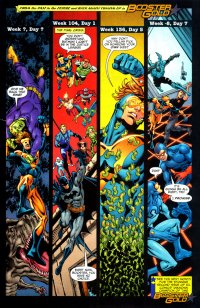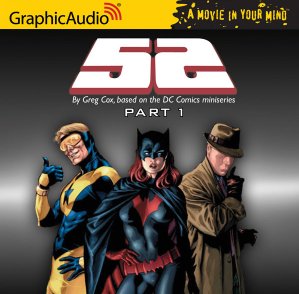
Previously, in the Future
August 27th, 2010 Posted by GavokOne minor thing in comics I’ve been digging in the past couple years is the “This Year in _____” pages that come out of the first issue. We haven’t had too many of them, but they’re pretty memorable when we do get them. For instance, Batman and Robin #1 featured a final page that depicted such things as Damian leaving in a huff to work on his own, Red Hood with a new sidekick, Batman and Batwoman fighting it out while Bruce Wayne Batman rises from the Lazarus Pit and a foreboding image of Doctor Hurt holding up the keys to Wayne Manor. All of these happened, as should be expected.
It’s probably one of the coolest concepts Geoff Johns has brought to the table in recent years and I say that knowing full well about his space cat that pukes acid blood powered by hate. When you start out a new series, it’s tough as is. Even if you have big plans several issues down the line, you have to win over the reader with both the first story and – more importantly – the contents of the first issue. This is more of a pitfall of Marvel, as their series tend to get cut to pieces by the fifth or sixth issue. Sorry, Jeff Parker. I think the teaser pages could really help some comics succeed in the long run. DC gave Magog a full twelve issues before finally cancelling it. It wouldn’t have hurt to get Giffen’s opinion on four developments planned that could have been exciting enough to bring up. Like a panel of Magog… uh… teaming up with the Shield? And the time he… um… Wait, I got this one. When he… Did I mention the Shield team-up? Okay, as much as I liked the series, maybe Magog isn’t the best example, but you know what I mean.
As far as I know, there have been four instances of the teaser pages, but feel free to correct me. There’s the aforementioned Batman and Robin #1 as well as Justice Society of America #1. I don’t read JSA, so I’m not going to talk about it in-depth, but I’ll touch on a little something later. The other two come from the same book, Booster Gold. Now that it’s moved to its latest creative team, I think now’s as safe a time as any to look back at what we were promised by Geoff Johns and Jeff Katz. Here we go, looking at the past about the future that’s become the past about a new future of a character from the past who came from the future. Sorry, what were we talking about?
This page comes from the end of Booster Gold #1.


